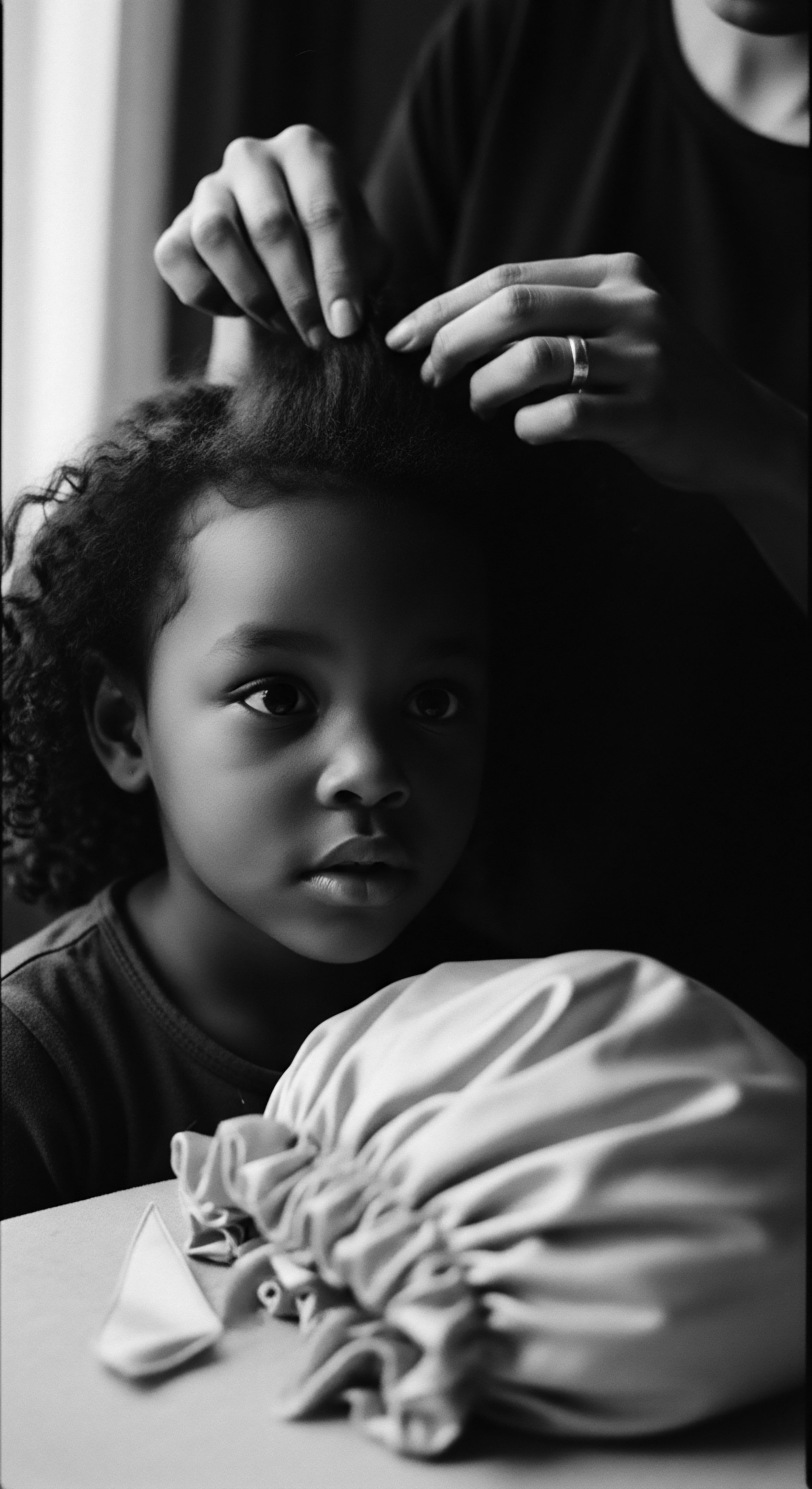
Fundamentals
The phenomenon of static hair, a momentary disarray where individual strands seemingly defy gravity and cling to anything nearby, represents a common experience for many, especially those who tend to the unique textures of Black and mixed-race hair. It marks a moment when the hair, often through friction, accumulates an electrical charge, causing repulsion among individual fibers. Understanding this initial scientific explanation, however simple, serves as a gateway to appreciating its implications for hair care and the long legacy of knowledge surrounding such interactions. This electrical charge, invisible to the eye, makes itself known through a sudden frizz, flyaways, or the feeling of hair standing on end, a familiar sight often encountered after removing a hat or during periods of dry air.
At its most elemental, static hair management describes the conscious efforts made to neutralize or mitigate this electrical imbalance. It means tending to the hair’s surface in ways that prevent the buildup of charges or dissipate them once they have formed. For those with textured hair, this practice carries a particular weight, given the inherent dryness of many curl patterns and the historical lack of products designed with these specific needs in mind.
The external environment, such as the dry embrace of winter air or arid climates, can intensify this electrical activity, making thoughtful care even more important. Conversely, humid conditions frequently offer a natural antidote, as moisture in the air acts as a conductor, drawing away excess charges and allowing strands to settle.
Many basic methods of static hair management have been intuitively practiced across generations. Simple approaches include hydrating the hair with gentle moisturizers or smoothing it with damp hands. These actions, often passed down through familial lines, speak to an ancestral understanding of hair’s relationship with its surroundings and its inherent desire for balance. Such foundational techniques, though seemingly straightforward, reflect a profound connection to the physical properties of hair and the environment.
Static hair management addresses the electrical charge that causes hair strands to repel each other, a challenge often met with deep, ancestral wisdom and practical solutions across textured hair traditions.
The initial recognition of static hair often occurs when garments are removed or when hair brushes against certain fabrics, creating friction that liberates electrons and creates an imbalance. This electron transfer leads to a net positive or negative charge on the hair shaft. When similarly charged, the hair strands push away from one another, resulting in the characteristic appearance of flyaways.
For those unfamiliar with the physics, the observation simply registers as an unruly hair day. However, for communities with a deep historical connection to hair as a cultural marker, remedies for such disturbances were sought and refined over centuries.
Effective static hair management often starts with foundational hair health. Properly moisturized hair tends to be less prone to static because its natural lipid barrier and internal hydration reduce the likelihood of electron transfer. A hair strand with adequate moisture absorbs and distributes charge more readily, preventing localized buildup.
This underlying principle has guided countless ancestral practices, where natural emollients and careful drying methods were prioritized to preserve hair’s intrinsic suppleness. The goal was, and remains, to foster an environment where hair remains soft, pliable, and in proper alignment.
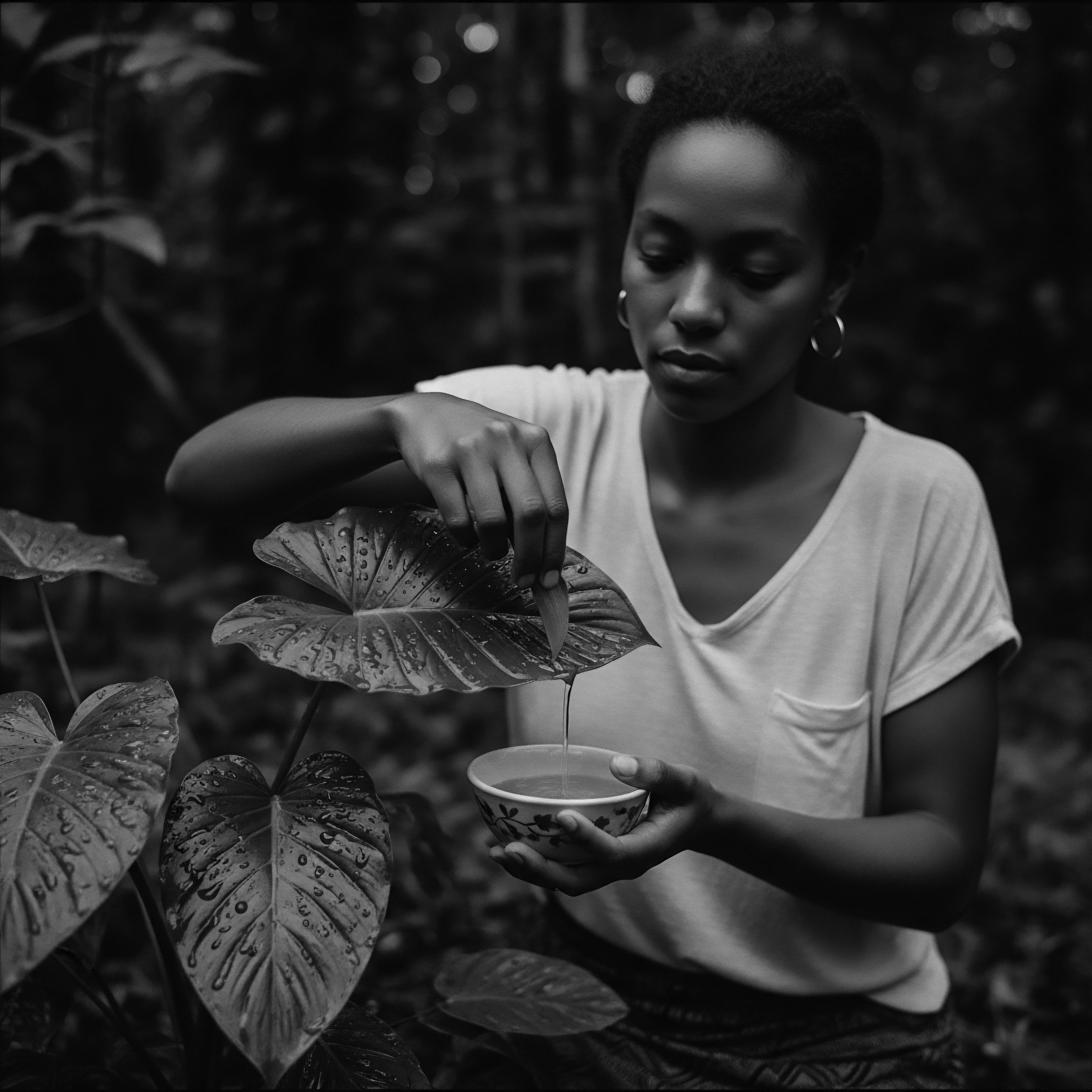
Intermediate
Moving beyond the immediate observation of flyaways, an intermediate understanding of static hair management acknowledges the nuanced interplay of environmental factors, hair porosity, and textile choices. It recognizes that static electricity, while a universal phenomenon, presents distinct challenges for textured hair due to its unique structural characteristics. Textured hair, particularly coily and curly patterns, often possesses a more raised cuticle layer compared to straight hair.
This anatomical distinction means there are more points of contact and friction for electron exchange, making textured strands particularly susceptible to charge accumulation. The dry air of winter months, for instance, strips humidity from the atmosphere, leaving fewer water molecules to act as natural conductors, thus intensifying the conditions for static to manifest.
The methods employed in static hair management extend beyond simple moisturization, encompassing a conscious selection of tools and materials. Historically, various cultural groups observed the effects of different materials on hair. Think of the smooth wooden combs and natural fiber cloths that were often preferred over rougher textures. These choices, made not through scientific analysis but through generations of careful observation, implicitly managed static by reducing friction and minimizing the generation of electrical charges.
The type of fabric rubbing against hair, whether it be a scarf or a pillowcase, significantly impacts the amount of static generated. Synthetic materials, with their inherent lack of moisture and tendency to build charge, contribute more readily to static challenges than natural fibers like silk or cotton.
Intermediate static hair management involves a deeper consideration of hair structure, environmental humidity, and the frictional properties of various materials, building upon foundational knowledge with culturally informed insights.
One of the key aspects in managing static on textured hair involves understanding its porosity. Hair with high porosity, often a characteristic of textured strands due to their raised cuticles, absorbs and releases moisture more readily. While beneficial for absorbing hydrating products, this rapid moisture exchange can also mean hair dries out more quickly, making it more vulnerable to static buildup in dry conditions.
Therefore, techniques that seal moisture into the hair become paramount. This often involves layering products, starting with a water-based moisturizer and following with a heavier oil or butter, a practice echoed in traditional methods of sealing in nourishment.
- Hydration Layers ❉ Applying water-based leave-in conditioners followed by natural oils or butters.
- Protective Headwear ❉ Utilizing scarves or bonnets made of silk or satin, materials known for their low friction properties.
- Natural Tool Selection ❉ Preferring wooden combs or boar bristle brushes to minimize static generation compared to plastic alternatives.
Community wisdom, transmitted across generations, offers invaluable insights into static hair management. Before the advent of modern hair products, communities relied on locally available natural resources and learned techniques passed down through familial lines. These practices were not codified scientific methods, but rather evolved as a collective response to the environmental challenges of hair care.
The collective experience of countless individuals contributed to a shared understanding of what kept hair supple and prevented it from becoming an unruly halo. This collective intelligence forms an invisible guiding hand for many contemporary hair care practices, even if the explicit scientific reasoning was only later articulated.
Consider the tactile feedback experienced when managing textured hair ❉ the feeling of a particularly dry strand, the subtle resistance when combing through. These sensory experiences, often dismissed in a scientific framework, have been vital in guiding traditional hair care. A hand reaching for a jar of shea butter or olive oil was an intuitive response to such dryness, a practical application of accumulated knowledge. This practical knowledge, often pre-dating formal scientific inquiry, represents a profound connection to the body and its needs, viewed through a deeply personal and familial lens.
| Aspect of Care Moisture Retention |
| Ancestral Practice (Historical Context) Regular application of plant-based butters and oils, like shea or coconut oil, often warmed. |
| Contemporary Method (Modern Parallel) Use of leave-in conditioners and moisturizing creams containing humectants and emollients. |
| Aspect of Care Friction Reduction |
| Ancestral Practice (Historical Context) Sleeping on natural fibers, wrapping hair with smooth cloths, or using smooth wooden combs. |
| Contemporary Method (Modern Parallel) Employing silk or satin pillowcases and bonnets; using wide-tooth combs or detangling brushes. |
| Aspect of Care Environmental Adaptation |
| Ancestral Practice (Historical Context) Adapting styling to humidity levels, protective styles in dry seasons. |
| Contemporary Method (Modern Parallel) Using humidifiers in dry indoor environments; anti-static sprays or specialized serums. |
| Aspect of Care These practices, though varied in form, share the consistent aim of balancing hair's electrical charge, a testament to enduring wisdom across time. |
The evolution of textile production further impacts static management. Historically, garments were predominantly made from natural fibers, which, while not entirely static-free, generally generated less static than many modern synthetic counterparts. As textile technology advanced, leading to the widespread availability of synthetic blends, new challenges in static became apparent.
This shift sometimes necessitated new adaptations in hair care, creating a continuous dialogue between technological progress and the timeless needs of textured hair. The ongoing search for materials that reduce friction and conduct electricity away from the hair speaks to this dynamic relationship.
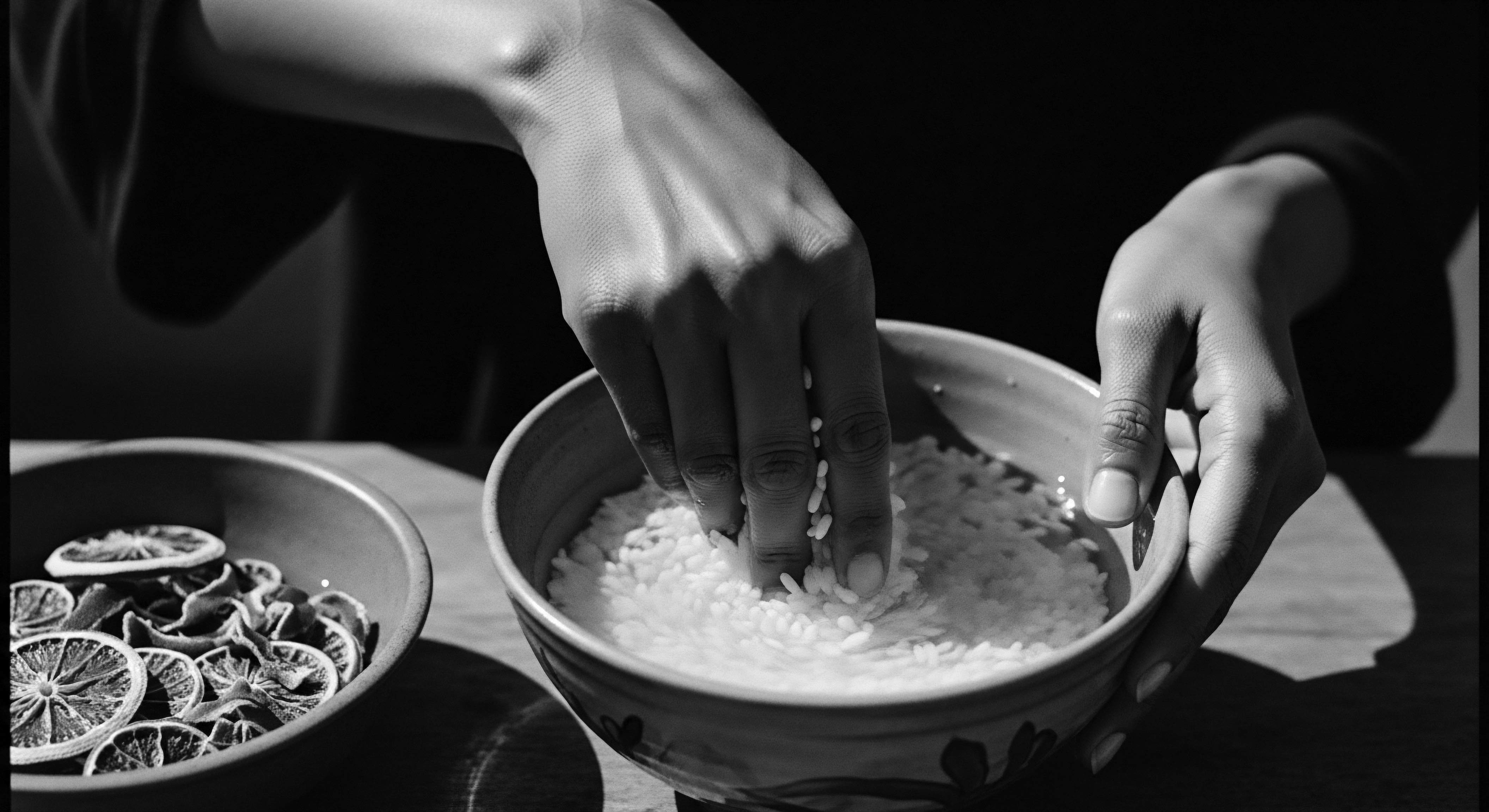
Academic
The academic investigation of static hair management transcends anecdotal observations, demanding a rigorous examination of triboelectric charging, surface chemistry, and the complex interplay of environmental physics with biological structures. This discipline, particularly when applied to textured hair, acknowledges that the propensity for static accumulation is not merely a cosmetic inconvenience; it is a direct consequence of hair’s unique morphology and its interaction with various surfaces, often exacerbated by specific environmental conditions. From an academic standpoint, static hair management encompasses the scientific understanding of how electrical charges are generated on hair, how these charges are dissipated or neutralized, and the efficacy of various interventions at the molecular and macroscopic levels. It involves a critical analysis of historical practices through the lens of modern scientific principles, seeking to validate and contextualize ancestral wisdom.
At the heart of static hair’s manifestation lies the triboelectric effect , a phenomenon where materials become electrically charged through contact and separation. When textured hair, characterized by its often elliptical cross-section and raised cuticles, rubs against another surface – a comb, a pillowcase, clothing – electrons are transferred from one material to the other. The material with a stronger affinity for electrons gains a negative charge, while the other becomes positively charged. Hair, being an electrical insulator, retains this charge readily.
This charge retention is particularly pronounced in dry environments where there are insufficient water molecules in the air to conduct electricity away, allowing the accumulated charge to persist, causing individual hair strands to repel each other due to like charges. The surface roughness and tortuosity of textured hair present a greater surface area and more points of friction, statistically increasing the likelihood of electron transfer compared to smoother hair types.
Academic inquiry into static hair management provides a rigorous scientific framework for understanding triboelectric charging on hair, validating ancestral practices through the lens of modern surface chemistry and environmental physics.
From an anthropological perspective, the methods of static hair management within Black and mixed-race hair traditions represent an enduring, applied ethnoscientific knowledge system. These communities, often originating from climates where hair needed extensive protection from dry winds or dust, developed sophisticated care rituals long before the advent of modern chemistry. The consistent use of natural emollients like plant butters and oils, for example, served not only to moisturize but also to create a conductive barrier on the hair shaft.
These practices, honed over millennia, implicitly addressed the underlying physics of static electricity. The application of oils and butters acts as a surface treatment, reducing the coefficient of friction and modifying the hair’s surface conductivity, thereby facilitating the dissipation of static charges and minimizing their initial generation.
Consider the profound role of traditional care in the Sahelian regions of West Africa, where dry winds often exacerbated static cling and brittleness in textured hair. The Dogon People of Mali, among other communities, have long practiced meticulous hair care involving the judicious application of Shea Butter (Vitellaria paradoxa), known locally as karité. This venerable practice, deeply embedded in their cultural fabric, served as a cornerstone of hair maintenance and communal identity. The application of shea butter, often warmed and massaged into the hair, provided a substantial lipid layer.
This rich, emollient coating demonstrably reduced the frictional charge accumulation on the hair strands. The lipids in shea butter act as a natural anti-static agent, lowering the hair’s surface resistivity and enabling the swift discharge of any accumulated electrical charge. The historical and continued reliance on such natural substances for hair conditioning is not coincidental; it is a testament to empirical observations regarding their effectiveness in mitigating static and preserving hair health in challenging environments. Maranz, S. (2009) discusses the traditional uses of shea butter for hair conditioning within West African communities, highlighting its importance for hair health and protection.
- Surface Conductivity Modification ❉ The application of lipids, such as those found in plant oils, creates a semi-conductive layer on the hair shaft, allowing accumulated charges to dissipate more readily across the surface.
- Friction Reduction ❉ Emollients smooth the hair cuticle, lessening the direct contact and electron transfer that occurs during rubbing, thereby minimizing charge generation.
- Moisture Equilibrum ❉ Hydrating agents maintain the hair’s water content, which further aids in charge dissipation and reduces the hair’s propensity to become an insulator.
The selection of materials for hair adornment and protective styling also presents a critical academic avenue. Historically, materials like bone, wood, or natural fibers were employed for combs and hairpins. These materials, often having a lower position on the triboelectric series relative to hair, or possessing inherent conductivity, generated less static compared to modern synthetic plastics.
A rigorous examination of various traditional textiles used for head coverings—ranging from finely woven cottons to animal hides—reveals a consistent preference for materials that reduced friction and offered insulation or breathability without contributing to static buildup. The choice of these materials was not arbitrary; it represented a sophisticated, albeit unarticulated, understanding of their physical properties and their practical implications for hair care.
Psychological and sociological dimensions of static hair management also warrant academic scrutiny. The unruly appearance of static hair can influence an individual’s self-perception and how they are perceived by others. In cultural contexts where hair plays a significant role in identity, aesthetics, and social expression, the ability to manage hair’s static qualities directly contributes to feelings of self-possession and pride.
This extends beyond mere vanity, touching upon issues of dignity, cultural continuity, and resistance against dominant beauty standards that historically devalued textured hair. The persistent effort to manage static, therefore, can be viewed as an act of self-care and a reaffirmation of one’s cultural heritage.
Contemporary research continues to refine our comprehension of static hair, investigating novel anti-static agents and advanced materials for hair tools. Polymeric compounds with specific charge-dissipating properties are synthesized, and ceramic or tourmaline-infused styling tools are designed to neutralize ions. Yet, even with these technological advancements, the fundamental principles often echo ancestral wisdom. The efficacy of modern humidifiers, for instance, directly correlates with the ancient understanding that moisture in the air calms unruly strands.
The pursuit of sophisticated solutions for static hair management often circles back to the basic yet profound truths known and applied by those who came before us, bridging the gap between historical ingenuity and contemporary scientific exploration. The very act of researching the properties of new polymers for hair reflects an ongoing dialogue with the inherent challenges posed by hair’s electrical characteristics.
The complexities inherent in textured hair, including its unique coily and curly formations, means a higher degree of inter-strand friction. This increased friction creates more opportunities for electron transfer, thereby raising the probability of static charge generation. This physical reality necessitates a comprehensive approach to static management, one that is as nuanced as the hair itself.
Research into the exact surface resistivity of different hair types under varying humidity levels, and the precise triboelectric ranking of various fabrics against human hair, continues to provide valuable insights for product development and care recommendations. These detailed investigations underscore the scientific validity of the intuitive practices that have long guided hair care within textured hair communities.
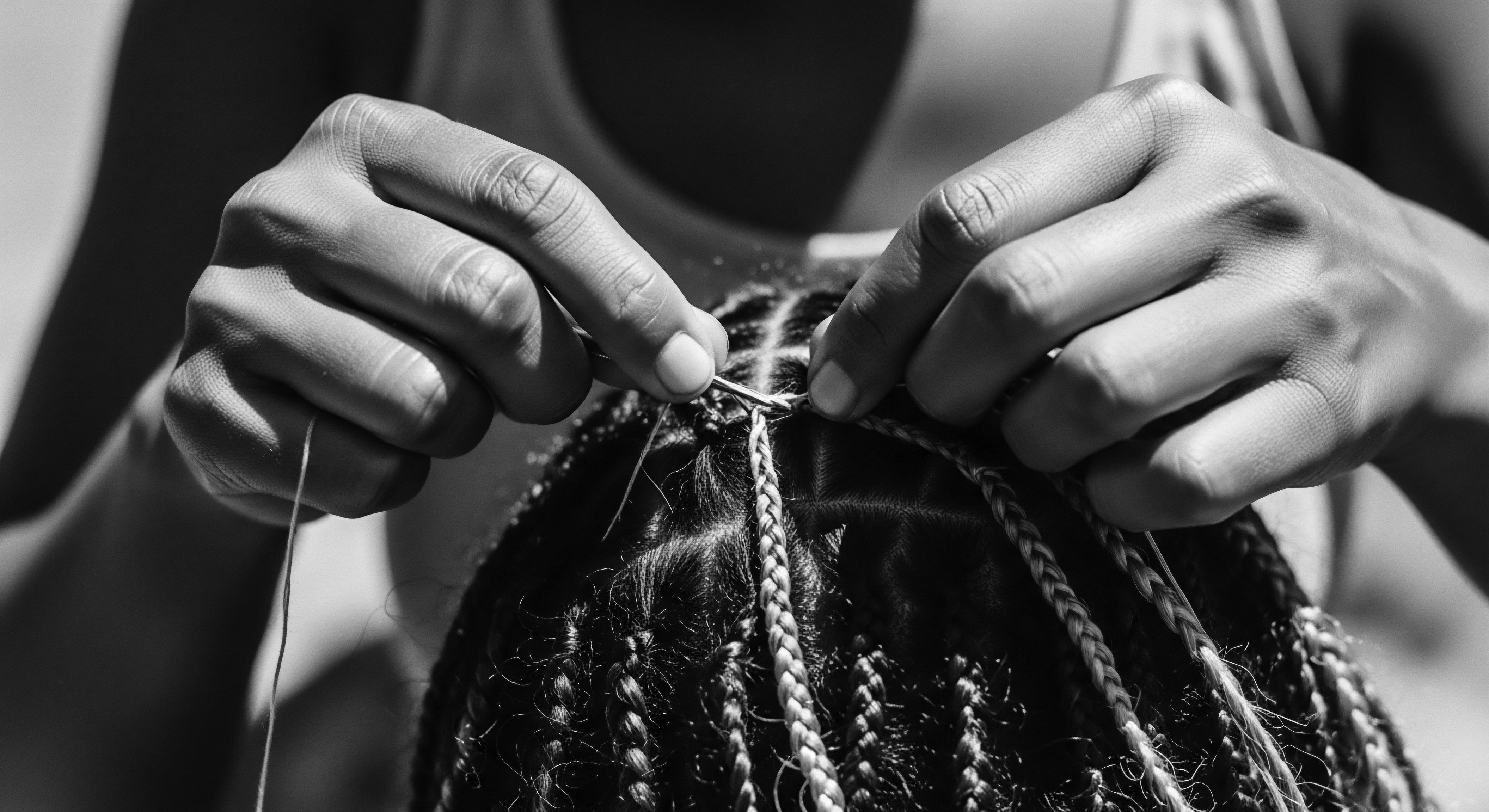
Reflection on the Heritage of Static Hair Management
As we consider the complexities of static hair management, a profound reflection emerges ❉ this seemingly mundane aspect of hair care holds within it the enduring echoes of ancestral wisdom and the resilient spirit of communities. Our journey from understanding the elemental physics of electrical charge to exploring sophisticated chemical interventions has consistently circled back to the heart of textured hair heritage. The practices for managing static, whether ancient or contemporary, are not merely technical solutions; they represent a continuous dialogue between humanity, the natural world, and the sacredness of our strands. The knowledge passed through generations, often through the gentle touch of a mother or grandmother applying natural butters, embodies a deep reverence for hair as a living extension of self and identity.
The quest for hair harmony, a state free from the disruptive pull of static, has driven innovation and sustained traditions across continents and centuries. From the sun-baked savannas where protective oils shielded coils from desiccating winds, to modern salons designing precise atmospheric controls, the objective remains constant ❉ to allow hair to rest in its natural state of grace and coherence. This pursuit is especially resonant for Black and mixed-race individuals, whose hair has historically been a canvas for cultural expression, a symbol of resistance, and a testament to enduring beauty. The very act of managing static is a small, yet significant, part of preserving that legacy, of tending to the tangible connection we hold to those who came before us.
Each act of applying a deeply conditioning balm, each choice of a smooth scarf for sleeping, each deliberate selection of a detangling comb, serves as a quiet affirmation of this unbroken lineage. It speaks to a heritage of observation, adaptation, and care that recognized hair not as an isolated entity, but as an integral part of holistic wellbeing, susceptible to the elements and responsive to nurturing hands. Static hair management, then, transcends a simple definition; it becomes a living testament to the ancestral intelligence embedded within our daily rituals, a delicate thread connecting us to the past while guiding us toward a future where every strand is celebrated for its inherent majesty and resilience.
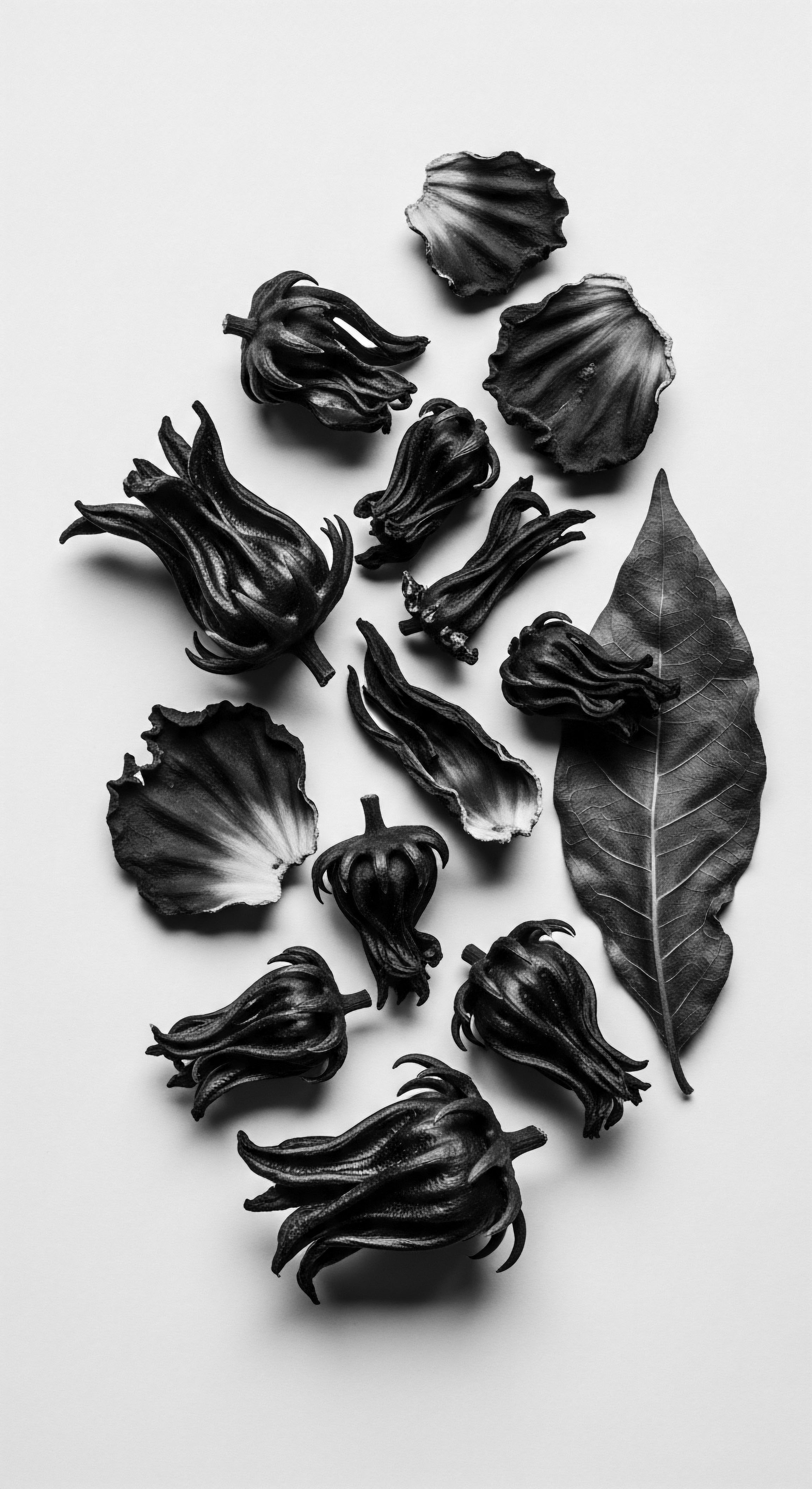
References
- Maranz, S. (2009). Shea butter ❉ A review of its biological activities. Phytotherapy Research ❉ An International Journal Devoted to Pharmacological and Toxicological Evaluation of Natural Product Derivatives, 23(11), 1546-1550.
- Robbins, C. R. (2012). Chemical and Physical Behavior of Human Hair (5th ed.). Springer.
- De la Mettrie, M. (2003). Hair and Hair Care ❉ A Practical Guide for the Haircare Industry. Cosmetics & Toiletries.
- Schildkraut, D. & Kress, M. (1976). Static electricity in hair. Journal of the Society of Cosmetic Chemists, 27(1), 1-13.
- Drealos, R. S. (2009). Cosmetic Dermatology ❉ Products and Procedures. Blackwell Publishing.
- Goldschmidt, W. (1993). The Human Career ❉ The Self in a Creative World. Blackwell.
- Byrd, A. D. & Tharps, L. D. (2014). Hair Story ❉ Untangling the Roots of Black Hair in America. St. Martin’s Press.
- O’Hear, N. (2007). African Ethnobotany ❉ Indigenous Knowledge and Plant Use. Continuum.
- Banks, I. (2000). Hair Matters ❉ Beauty, Power, and Black Women’s Consciousness. New York University Press.
